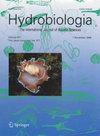Ichthyofauna from the Zoque Rainforest of Santa Maria Chimalapa, Oaxaca, Mexico
IF 0.3
4区 生物学
Q4 MARINE & FRESHWATER BIOLOGY
引用次数: 0
Abstract
Background. The Zoque rainforest Chimalapas is located in the Isthmus of Tehuantepec, mainly in the municipalities of San Miguel Chimalapa and Santa Maria Chimalapa in the state of Oaxaca, is considered one of the latest well-preserved regions in Mexico, as well as a center of diversity and endemism of flora and fauna. Objective. Develop inventories of the ichthyofauna from Santa Maria Chimalapa rainforest to catalog resources before imminent environmental and human alterations. Methods. Samples were collected using several types of fishing gears in the main rivers and tributaries of the water system. Results. A total of 2,430 fish were collected, corresponding to 38 species, grouped in 31 genera, 19 families, and 12 orders. The families with the greatest species richness were Cichlidae and Poeciliidae with nine and six. Priapella intermedia was the most abundant (30.1% total), followed by Astyanax finitimus (13.3%) and Pseudoxiohophorus bimaculatus (10.3%). Regarding biogeographical aspects of the fish community, a prevalence of neotropical species (91.9%) was observed, two species of Nearctic origin (Ictalurus meridionalis and Ictiobus meridionalis) and four vicarious species (Atherinella sallei, Cathorops cf. kailolae, Eugerres mexicanus, Strongylura hubbsi). 31 species are being evaluated in some risk categories and two are exotic. Conclusions. The ichthyofauna of Santa Maria Chimalapa holds similarities to that of the aquatic bodies present in rainforests of southern Mexico. However, ecological, conservation and anthropogenic impact studies are necessary to establish sustainable conservation strategies.来自墨西哥瓦哈卡州圣玛丽亚奇马拉帕的Zoque雨林的鱼类
背景Zoque热带雨林Chimalapas位于特万特佩克地峡,主要位于瓦哈卡州的San Miguel Chimalapa和Santa Maria Chimalaba市,被认为是墨西哥最新保存完好的地区之一,也是动植物多样性和特有性的中心。客观的编制Santa Maria Chimalapa热带雨林鱼类动物名录,在即将发生的环境和人类变化之前对资源进行编目。方法。使用几种类型的渔具在水系的主要河流和支流中采集了样本。后果共收集到2430条鱼,对应38种,分为12目19科31属。物种丰富度最高的科是慈鲷科和朴丽科,分别有9个和6个。中间普里apella intermedia最为丰富(总数量为30.1%),其次是有限Astyanax finitimus(13.3%)和双斑假雄藻(10.3%)。在鱼类群落的生物地理方面,观察到新热带物种的流行率(91.9%),近北起源的两个物种(Ictalurus meridionalis和Ictiobus meridionalys)和四个替代物种(Athernella sallei,Cathops cf.kailolae,Eugerres mexicanus,Strongylura hubbsi)。31个物种正在评估一些风险类别,其中两个是外来物种。结论。Santa Maria Chimalapa的鱼类与墨西哥南部热带雨林中的水生生物有相似之处。然而,生态、保护和人为影响研究对于制定可持续的保护战略是必要的。
本文章由计算机程序翻译,如有差异,请以英文原文为准。
求助全文
约1分钟内获得全文
求助全文
来源期刊

Hidrobiologica
生物-海洋与淡水生物学
CiteScore
0.40
自引率
0.00%
发文量
8
审稿时长
>12 weeks
期刊介绍:
HIDROBIOLÓGICA es una publicación cuatrimestral que difunde trabajos originales e inéditos de investigación o revisión, sobre temas relacionados con los organismos y la hidrología de los ambientes acuáticos, dulces y marinos y va dirigida a investigadores de todo el mundo, interesados en las diversas disciplinas que incluye la Hidrobiología , así como a alumnos de posgrados y licenciaturas relacionados con la biología, ecología, taxonomía, filogenia y evolución de organismos acuáticos, e hidrología y oceanografía de ambientes s dulceacuícolas y marinos.
 求助内容:
求助内容: 应助结果提醒方式:
应助结果提醒方式:


